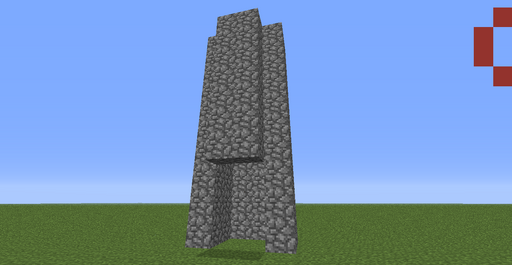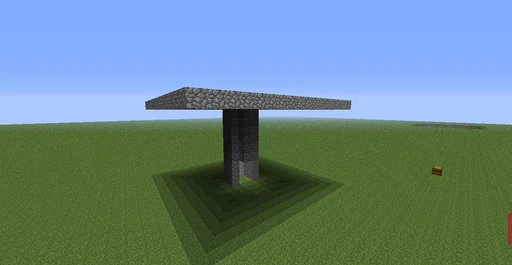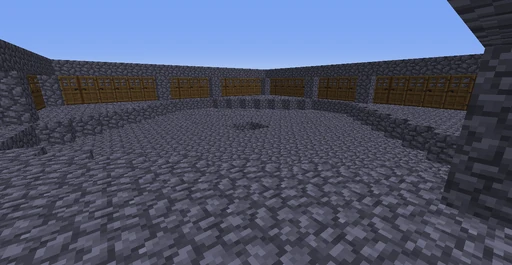| Line 20: | Line 20: | ||
{{yt|XQDiw_kMXF0}} |
{{yt|XQDiw_kMXF0}} |
||
| − | == Design by JL2579(tutorial by docm77) == |
+ | == Design by JL2579 (tutorial by docm77) == |
'''Requires spawn chunks''': no<br /> |
'''Requires spawn chunks''': no<br /> |
||
Revision as of 15:20, 30 August 2014
An Iron Golem farm is an easy way to acquire many iron ingots (and less useful poppies) with minimal effort after the initial setup. It is an artificial village (or several of them, spaced far enough apart to remain separate) in which golems are spawned and then either killed immediately, or moved to a holding cell (outside the village boundary, so that new ones can spawn in their place) for later killing. If you opt for the first method, you will either need to go AFK while camping out at the collection point, have a hopper collecting your items, or else check back periodically to collect your items before they despawn. This necessity can be avoided by using the holding cell method, which allows the golems to collect while you are working nearby, and then you can harvest them all at once when you are ready so that you don't miss any drops.
General requirements
There are several ways to build an iron farm, but the decent versions seem to be the ones that use two floors in the golem-spawning zone(16 by 16 by 6), and keep all doors and villagers outside the zone, either above and below the center or in an outer "ring" on the same level. This is in order to maximize the number of available spaces for the golems to spawn in, which in turn will reduce the number of failed attempts, and keep the spawning rate as high as possible. This is much more effective than simply increasing the villager count to raise the golem cap, which only matters for the few seconds between the time when a golem spawns and when it is flushed out and killed. To further increase your output rate, you can build several separate iron farms as long as they are 64 blocks apart, and bring the golems or their drops to a central collection area. The most powerful iron farms are ones that overlap many villages. Tango Tek is the user who discovered the process himself. Since golems are immune to falling or drowning damage, the available killing methods are lava or suffocation (or both like docm77's video.)
Odds of a missed spawn occurring: The previous section is generally true but contains an invalid assumption about the odds. There are 512 valid spawn points in the 16x16x6 block spawn area. Making a farm with only ½ of the valid spawn points (256) does not reduce your chance of spawn by ½. This is because the game randomly "tries" to find a valid place to put a golem 10 times each time an opportunity to spawn a golem comes up. So, your chances become 0.5 for each of the ten tries. Missing a spawn in this case is equivalent to flipping a coin ten times and have all ten come out tails. It is .5^10 or .00098 which is just about one in a thousand odds. A better suggestion would be to use some of the area of the zone to rapidly move golems out of the interference zone so they do not halt further spawning. This is a much more likely occurrence than missed spawns if the golems can’t move out of the area quickly. This is not as rare of an occurrence as has been suggested.
Video
Tutorials/Door-based iron golem farming/video
Design by trunkz
Requires spawn chunks: no
Iron per hour: 40
Description: This is an older design by trunkz and one of the earliest to feature two spawning floors for greater efficiency. It uses several villager baskets and door pads and is a little outdated, but quite a good and efficient design for the time it takes to build.
Design by JL2579 (tutorial by docm77)
Requires spawn chunks: no
Iron per module per hour: 40
Iron per hour: 160
Description: This design, originally created by JL2579, uses 4 farms spaced 64 blocks apart. It uses 4 spawning modules, with 2 modules per level, with doors surrounding the modules. This pattern could be repeated to fill a very large area with iron farms. The farm also features a lava system to damage the iron golems so that the piston suffocator works more quickly. Youtuber docm77 made this tutorial for the design.
Design by Nims
This design by NimsTV is slightly less efficient then JL2579's design but it is simpler and easier to build which would take less time because the water streams are much easier to configure and there is only one villager basket. The golem spawning area is actually larger than the farm, which is why JL2579 did not build his farm in this way because you have to block spawning anywhere outside the farm, if you intend to build several duplicate farms in an array.
Designs by Tango Tek
These designs by Tango Tek have revolutionized iron-farming in Minecraft. If you are the minecrafter who has a lot of redstone or effort and availability to spawn chunks, these 5 farms below are for you. All of them use the concept of village overlapping, which uses a clever order of placing and breaking doors against the way the game intended to allow. However, if the chunks containing these chained village are unloaded, all of the villages will combine into one giant village and the farm will break, meaning that the designs also need a way to keep the chunks constantly loaded or automatically rebuild the villages. Designs that keep the farm loaded constantly do not need much redstone, but must have access to the spawn chunks and take a lot of time to place and break doors. Designs that automatically rebuild the villages require a lot of redstone, but don't need the spawn chunks, and can therefore be built on public servers. If you want to understand this processes better, watch the explanation section of the Iron Trench. Chaining has changed slightly in 1.8+ and is slightly more difficult, because you have to set up 8 additional strips for doors, thus making it harder to track the door placement, whereas in 1.7 and below you only need set up one additional strip for doors, and therefore making it much more easier to track the door placement.
The Iron Trench
~1300 iron per hour: not scale-able: does NOT require spawn chunks.
The first farm of its kind, using a ton of redstone to automatically chain the villages in a 20 minute process. Unfortunately, the redstone was VERY complicated and quite expensive, likely one of the most complicated redstone systems intended to be build-able in survival ever, using many logic circuits, timers and bus wires. This meant that is was very difficult for the average Joe to build and keep working. Definitely watch the "How it Works" and the "Watch it Rebuild" sections just to get an idea of how these farms really work. Tango even has a mod, created for him by KaboPC, that shows all of the villages. Then move on to the Foundry or Titan, as they are much more efficient and far cheaper to build. This design will be broken in 1.8.
The Iron Foundry
~1700 iron per hour: somewhat scale-able: requires spawn chunks
A vast improvement on the Trench, the Foundry gets rid of all the redstone by using a different mechanism to keep the farm loaded. The Trench simply allowed the farm to break and then auto-built itself when it did. The Foundry never lets it break in the first place. The Foundry must be built in the spawn chunks and uses a funky mechanic with Nether Portals to keep the farm always loaded, even if the player goes to the Nether or the End. This means the the villages can be chained manually one time and then never touched again. This design cannot be built in 1.8, however if you build it in 1.7 or below and then upgrade to 1.8 it will still work, since 1.8 only affects the village chaining process.
The Iron Titan
~2600 iron per hour: very scale-able: DOES require spawn chunks
In 1.8 snapshot 14w04a, villagers were completely reworked, including the way doors were seen. Previously, a new door would be added to the oldest village center in range. Now, doors are added to the closest village center within range. For a while, everyone thought that since chaining was broken, there was no way to get amazing iron farms like the Foundry to work in 1.8. But Tango Tek responded by changing the way he did chaining with a slightly different process. He used the new chaining in designing The Iron Titan. It is very similar to the Foundry, but this one is far more modular, and can be easily scaled up in increments of 32 villages. Tango's recommended design has 64 villages which produces a whopping 2600 iron every hour. It can theoretically be stacked on top of itself indefinitely, but that would obviously be very expensive and quite unnecessary.
Designs by DanielKotes
The Lava Trench
Several variations of Tango's original iron trench which allowed the farm (build-able up to 1.7 version) to be scaled up from 32 villages to 128 or even 256 sizes. These farms use the same technique that Tango came up with, but optimize the redstone to be easier to build/understand, allow resets to be done without player interaction even in the middle of an ongoing reset, and as already mentioned are not limited to 32 villages in size. A completely overpowered farm with 512 villages was also designed and can be seen in the video that shows all the other variations as well. For anyone interested, the youtube minecrafter ElRich actually managed to build the 512 village farm by himself in his single player survival, although it took him over half a year to build.
The Iron Towers
Very similar to the Iron Trench, the Iron towers design layers villages one over each other to produce 32 villages. Due to the change in village creation mechanics introduced in 1.8, the previous designs have all been broken and thus a completely different setup was required. Unlike the Iron Titan (which is also buildable in 1.8 onwards only), the Iron towers can be built outside the spawn chunks and will re-build the villages if they are broken, not requiring any player intervention. At the moment it can only be built up to 32 villages in size, thus producing at most 1300 iron per hour if the full 32 village farm is built. Fortunately the redstone in this design is much simpler than the older iron trench builds due to the village building process being done in one phase instead of 2.
For anyone interested, there is a tutorial available for the iron towers design:
Tower design
This design is good especially for survival. It will get you about a stack every 2 hours. It's pretty efficient, but for faster farms, use one of the above.
Step zero - resources
To build an iron golem farm, you should have a fair amount of resources, such as cobblestone and wood, as well as a way to get villagers into it.
You will need:
- at least 1100 cobblestone (about 18 stacks)
- 64 doors (6 wood per door=384 wood planks or about 6 stacks.) (In 1.8 snapshots three doors are received instead of one)
- 18 water buckets
- 1 lava bucket
- 4 signs
- 2 hoppers and 2 chests (This is for the option to use hoppers to collect items when you are away from the farm)
Step one - Building location
To build the Iron Golem farm you should:
- Choose a good location. Don't build it far from your home or main base, because you want the golems to spawn even when you are not at the farm. An ideal spot is on top of your existing home or close to it.
- Gather the resources listed above.
- Follow the instructions below to begin building the base.
Step two - Building instructions
- 1.
Start by building a 4x4 cobble base.
- 2.
Continue this until you have a tower that is 10 blocks tall. Next, break a 2x3 hole in the bottom so the golems will be able to go through.
- 3.
Build out 7 blocks from the top of this tower to form an 18x18 platform with a 2x2 hole in the middle.
- 4.
Build in 4 blocks from each corner, then 3 blocks diagonal in both directions to build a triangle.
- 5.
Next build a 1 block wide platform around this so the platform is now 20x20.
- 6.
Now build a wall with windows in it as show below.
This is how wide each of the holes in the wall should be:
- 7.
Seal off the backs of the windows, and build some small cups to hold the villagers. The cups should be 4x4 on the outside, so there is 2x2x3 of air on the inside.
- 8.
Place doors against the back of the indents. This is to make the villagers think these are homes.
it should look like this:
- 9.
Then place down 1 water in each of the 4 villager cups, and 2 water down in between each of the raised triangles to form this pattern: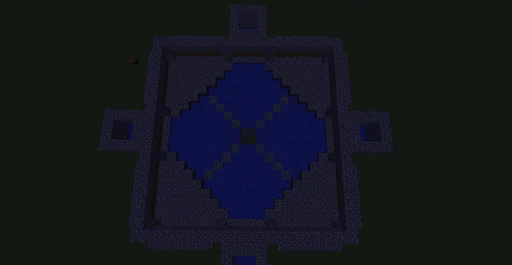
- 10.
Place 1 water on each of the triangles in the very back corner of the wall.
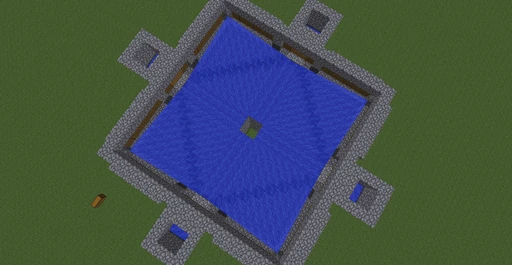
Now the top part is finished, the golems will spawn once there are 3 villagers in each of the holding cups.
The next step is to build the golem grinder.
- 11.
Build 4 blocks out from the bottom of the tower and 3 blocks up on each side, then place 2 blocks at the end of it to keep the golems from escaping.
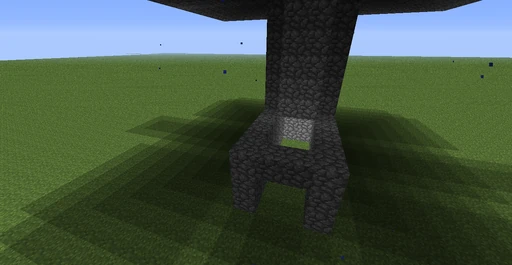
- 12.
Next, place 4 signs in a cup shape to hold the lava that kills the golems.

- 13.
Now place the lava in the signs.
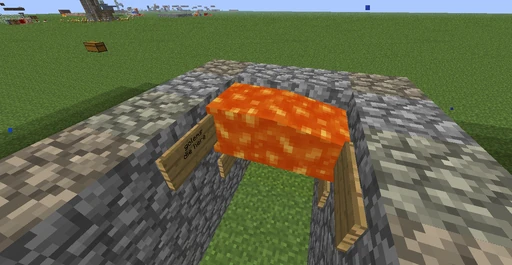
- 14.
Place the last 2 water in the very back of the base, so the golems will get pushed into the lava.

- 15.
Put down 2 hoppers going into a large chest for automatic resource collection (this is not required, but it is a good idea so you don't let any of the items despawn.)


